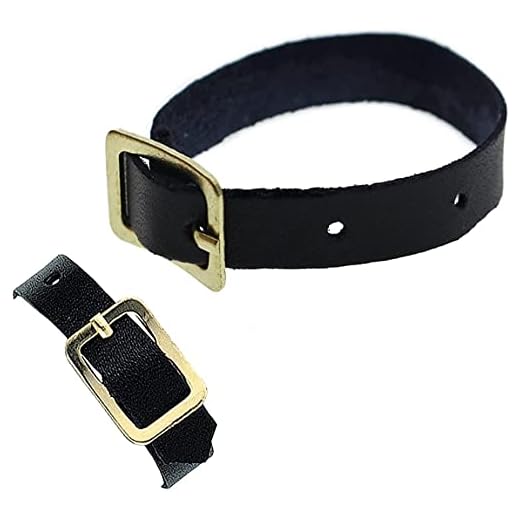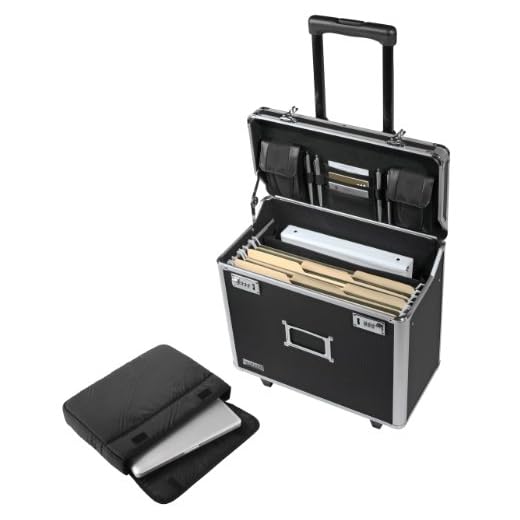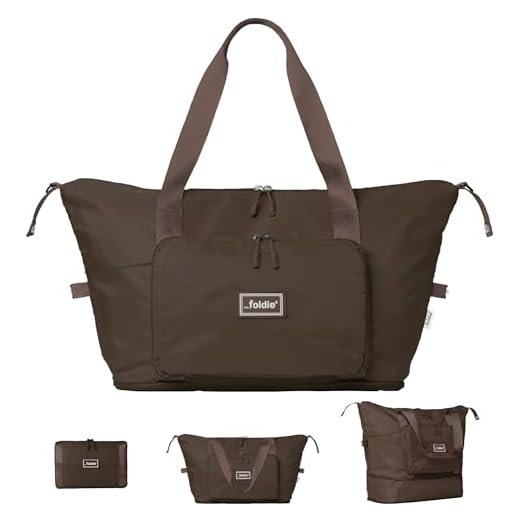



Rationale: telescopic handle assemblies are engineered for steering and light stabilization, not for heavy cantilever loads. Limiting added weight to ≤5 kg minimizes bending moment on the tubes and reduces risk of tube deformation, retraction failure or zipper seam damage. If any handle tube shows play, wobble or fails to retract smoothly under load, remove the item immediately.
How to secure: best option – slide the bag’s pass-through sleeve over the extended tubes. If no sleeve exists, align the bag’s long edge parallel to the tubes, center it over the wheel axle, then fasten with a woven strap at least 25 mm (1 in) wide with a cam or quick‑release buckle. Alternative: a short elastic luggage strap (30–50 cm unstretched) plus a non‑metallic protective pad at contact points to prevent abrasion. Avoid hooking weight directly on single plastic clips or zipper pulls.
Placement and orientation: keep the mass low and centered: long side of the document case parallel to tubes, midpoint aligned with suitcase centerline. This reduces torque on the handle mounts. Do not place the bag perpendicular to the tubes or hang it off one side; that increases lateral stress and risks tilting or uncontrolled movement during transit.
Operational checks and travel rules: verify handle retraction and wheel tracking after fastening, and test by rolling two meters on level ground. Combined external size can exceed airline cabin limits – common carry-on maximum: 56 × 36 × 23 cm (22 × 14 × 9 in) – and many carriers enforce cabin weight limits in the 7–10 kg range for carry items; if combined mass or dimensions exceed limits, stow the item in the checked compartment or use an airport trolley. Use TSA‑approved locks where required.
Handle-mounted work bag: practical guidance
Avoid resting a portfolio on a telescopic handle unless its mass is ≤5 kg (11 lb) and the case remains stable during a brief stability check.
Weight, balance and testing
Keep external load under 5 kg; for very lightweight shells (empty weight <3 kg) limit external mass to ≈30% of shell weight. Place the bag so its base sits within 10 cm of the handle base and heavy contents sit at the bag bottom. Stability test: walk briskly for 3–5 m and apply a short forward push; if the unit veers, tips, or the handle housing flexes, relocate the bag or reduce its contents.
Securing methods and safety
Prefer a built-in trolley sleeve. When using an external strap select one ≥25 mm wide with a minimum tensile rating of 500 N; use metal clips rated ≥1 kN for attachments. Avoid fastening to thin plastic housings or zipper pulls. Inspect the telescopic mechanism for play or bent tubes before loading; visible deformation means no external load. Airlines often require items to be stowed during taxi/takeoff/landing and some manufacturers void warranty for handle-mounted loading–store valuables inside the main compartment during flight and in crowded spaces.
Airline and security rules for securing a business case to telescopic handles
Recommendation: fasten a laptop or business carrier to the extended telescopic handle using the integrated pass‑through sleeve or an adjustable luggage strap; keep added mass under 5 kg (11 lb) and position weight over the trolley’s wheels to reduce tipping and stress on the handle mechanism.
Airline policies: verify the carrier’s cabin allowance before boarding. Typical cabin bag dimensions are about 55 × 40 × 20 cm (22 × 16 × 8 in); personal‑item mass limits commonly range 7–12 kg depending on fare class and operator. Some carriers treat externally attached small cases as a separate item or prohibit external attachments entirely; oversized or protruding items are frequently requested to be gate‑checked.
Security screening: TSA and equivalent agencies require all items to be screened. External attachments that obscure contents or block X‑ray access may be subject to separate inspection or removal. Keep liquids and large electronics easily accessible for removal; expect manual inspection when the pass‑through sleeve prevents adequate imaging.
Onboard safety: during taxi, takeoff and landing all cabin items must be stowed in an overhead bin or under the seat; hanging a secondary carrier on an extended handle during these phases is often refused by crew. Unsecured items can become projectiles in turbulence, so secure fastening while moving through the terminal is acceptable, but stowage is required for flight phases specified by crew.
Recommended hardware and methods: use a rated travel strap with quick‑release buckle and low‑profile connectors; prefer the bag’s integrated rear sleeve over wrap‑around ties or heavy metal clips that introduce torque on the telescopic tubes. Check handle locks and tube alignment after attaching an extra load; discard attachments that cause play, bending or difficulty retracting the handle.
Enforcement and penalties: gate agents may require removal, gate‑checking or levying oversize charges for noncompliant external attachments. Noncooperation during security screening can result in secondary checks and boarding delays.
For compact rain protection of carried items consider a collapsible option such as best umbrella for strong wind and rain.
Practical fastening methods: straps, luggage sleeves, and clip systems
Use a 38–50 mm (1.5–2 in) nylon webbing strap with silicone non-slip backing and a metal cam or quick-release buckle; choose webbing with a minimum breaking strength of 500–900 N (≈110–200 lbf) for everyday carry items.
Strap routing: pass the strap beneath the telescopic handle tube, across the rear panel of the roller or suitcase, then through the buckle and tension until the case sits flush on the handle. Trim excess tail to 50–100 mm and secure with a rubber keeper or hook-and-loop patch to prevent flapping. For added grip, place a 2–3 mm silicone anti-slip strip between surfaces.
Sleeve options: a fixed or removable trolley sleeve should be 200–300 mm long and 30–50 mm deep to accept most handle profiles; reinforced ballistic nylon or Cordura with internal stiffening keeps the opening aligned during insertion. Zippered sleeves with internal webbing anchors provide higher lateral stability than simple pass-through pockets.
Clip systems: prefer stainless steel or aircraft-grade aluminum carabiners with screw- or auto-lock gates rated 2–5 kN for primary attachment points. Swivel snap hooks or spring-loaded snap clips work for lightweight cases but add a secondary safety loop to avoid accidental release. For handle tubes 18–22 mm diameter, use a split-loop or clamping webbing connector to ensure a positive bite without deforming the tube.
Configuration tips: use two attachment points spaced at least 120 mm apart to limit rotation; keep the combined weight of the document case and contents below 7–10 kg to avoid stressing the telescopic mechanism; test the assembly on level and inclined surfaces before transit. Designate one quick-release clip accessible for inspections and one locking connection for transit security.
Weight limits, balance and how to prevent suitcase tipping
Limit any top-mounted add-on mass to 5 kg (11 lb) maximum; optimal stability achieved with 2–4 kg (4.4–8.8 lb).
Where to place mass
- Locate the heaviest items at the base, adjacent to the wheel axle and back panel; target the center of gravity (CG) within the lowest third of case height. Example: for a 60 cm high case, keep CG below ~20 cm from the base.
- Keep dense items centered between sidewalls to avoid lateral tipping; distribute odd-shaped items symmetrically.
- Soft items that compress should go around rigid gear to prevent sudden CG shifts during movement or handling.
Simple physics check and practical tests
- Tipping moment scales with added mass times horizontal offset from wheel axle: Moment ≈ m·g·d. Example: 5 kg located 0.25 m behind axle → ~12.3 N·m.
- Stability test: fully extend the telescopic handle, lift by the handle until only rear wheels contact the floor. If the front corners lift more than a few centimetres or the case tips backward without counterforce, reduce top-mounted mass.
- Rolling test: with gear attached, walk at normal speed and stop abruptly on flat ground; if the packed case pitches backward or requires continuous hand support to stay upright, remove or redistribute weight.
Design differences: two-wheel roller designs typically tolerate higher rear-mounted loads because the axle sits lower and farther back; four-wheel spinners have a higher pivot point and may need a 20–30% reduction in top-mounted mass for equivalent stability.
- Use a handheld scale to verify accessory mass before mounting; target ≤5 kg.
- Secure internal contents with cross-straps or compression cubes to prevent shifting that raises the CG mid-trip.
- When stationary on inclines or curbs, collapse the handle and lay the case flat or brace it against a stable surface to avoid roll-back.
For unrelated gear recommendations that pair well with compact, balanced travel setups, see best cordless lawn mowers for medium gardens.
Work-satchel and suitcase features to look for when mounting on handles
Select a business satchel with a full-length pass-through sleeve at least 18 cm long and 6 mm high, reinforced with bartacks and a 2–4 mm rigid insert so the bag slides over telescopic rods without collapsing.
Back-panel construction: flat profile within 10 mm tolerance, abrasion-resistant fabrics (Cordura 500–1000D or 1680D ballistic nylon; full-grain leather with reinforced backing), horizontal reinforcement strips sewn at 3–5 cm intervals, and a non-slip silicone or rubber strip at least 20 mm wide across the lower third of the panel.
Sleeve geometry and clearance: internal sleeve opening sized to accept dual-rod telescopes with tube diameters 8–15 mm and inter-tube spacing 30–80 mm; sleeve length minimum 18–22 cm to clear handle stops; top-edge design should be low-profile to avoid catching on retraction mechanisms.
Hardware and seams: YKK or equivalent zippers with recessed channels; bartacked stress points at all attachment seams; metal fittings with less than 8 mm projection to prevent snagging; stitch density ≥8 stitches per inch in load-bearing areas.
Suitcase features that improve fit: recessed telescopic housings leaving a 5–15 mm channel between retracted tubes and the rear wall; flush rear panel without external pockets in the handle zone; handle mounting plates that distribute load over ≥6 cm² to reduce point stress on pass-through sleeves.
Profile and contact details: satchels with depth under 8 cm when empty reduce forward canting; rounded lower corners at the contact interface increase contact area and lower abrasion; wide-set wheels and a rear skirt on the roller enhance lateral clearance for a snug interface.
Compatibility checklist for purchase decisions: measure tube diameter and inter-tube distance, confirm sleeve height ≥6 mm and length ≥18 cm, verify reinforced back panel and bartacked seams, check for non-slip backing and a flush suitcase rear with recessed telescope housing.







